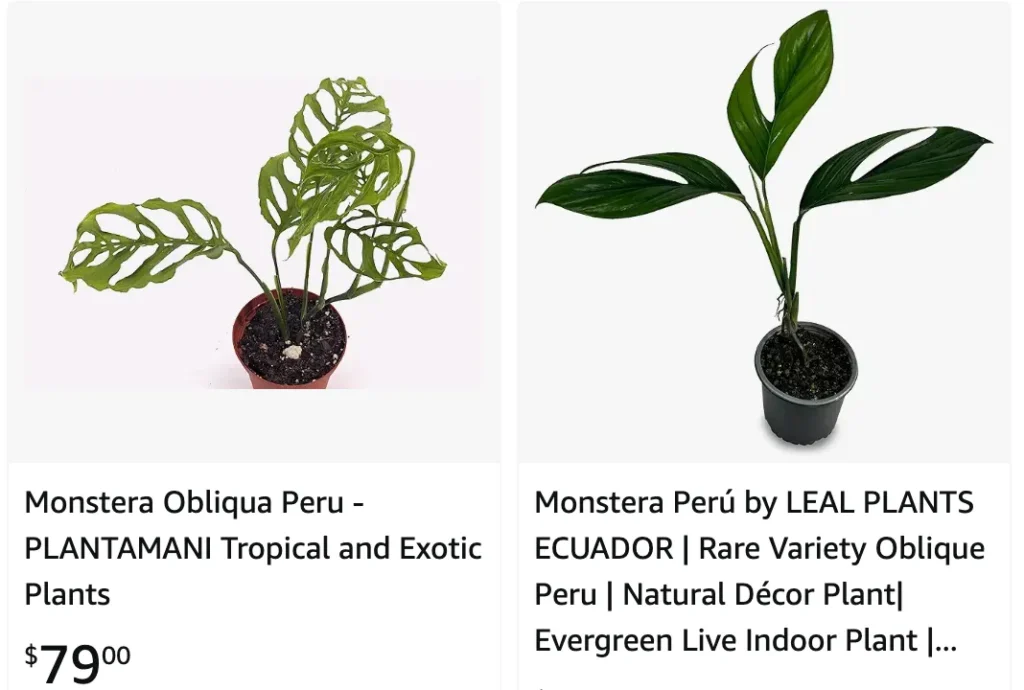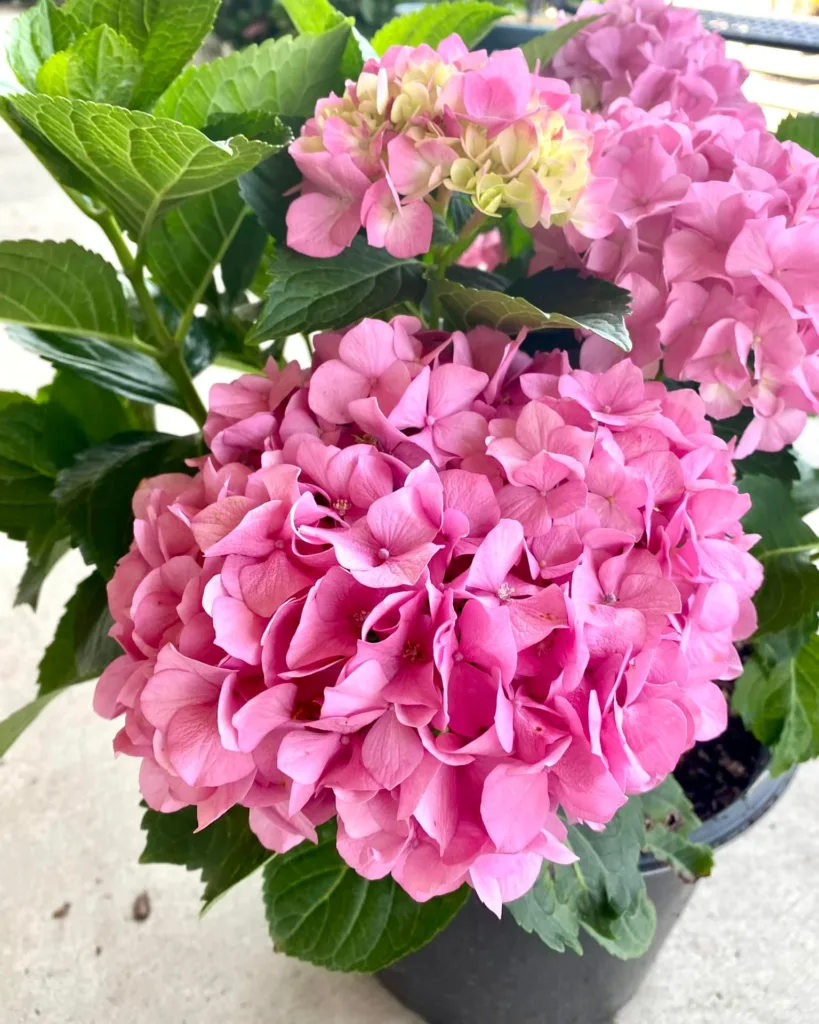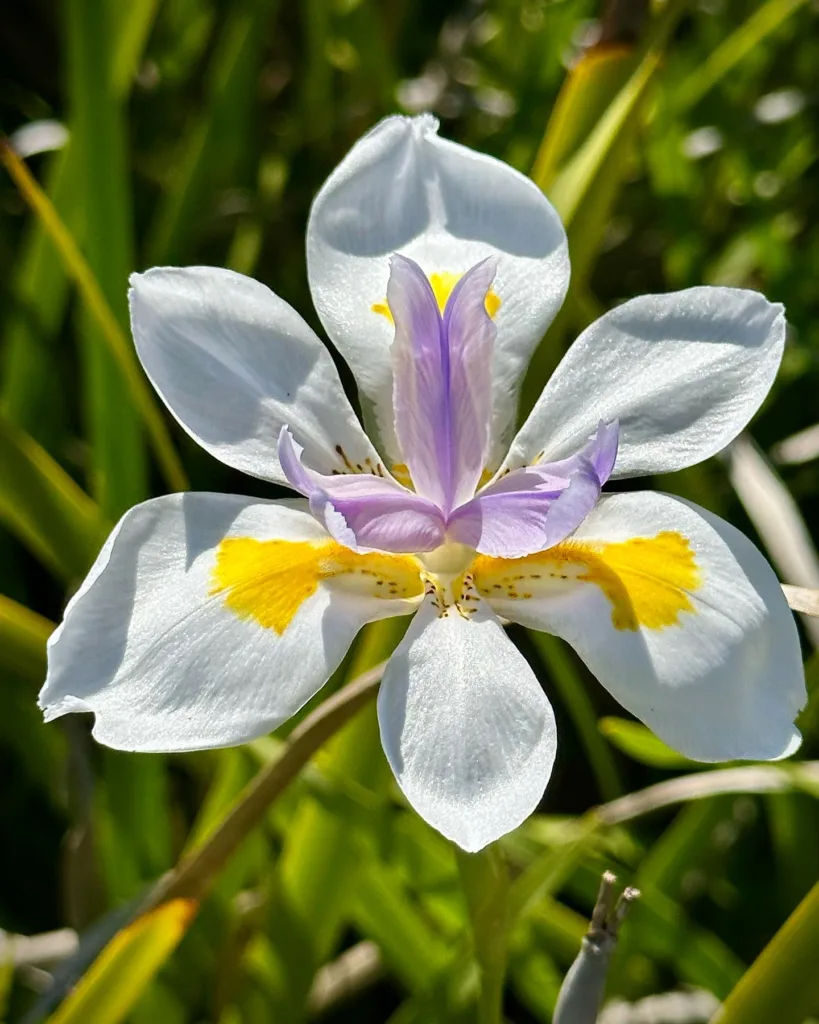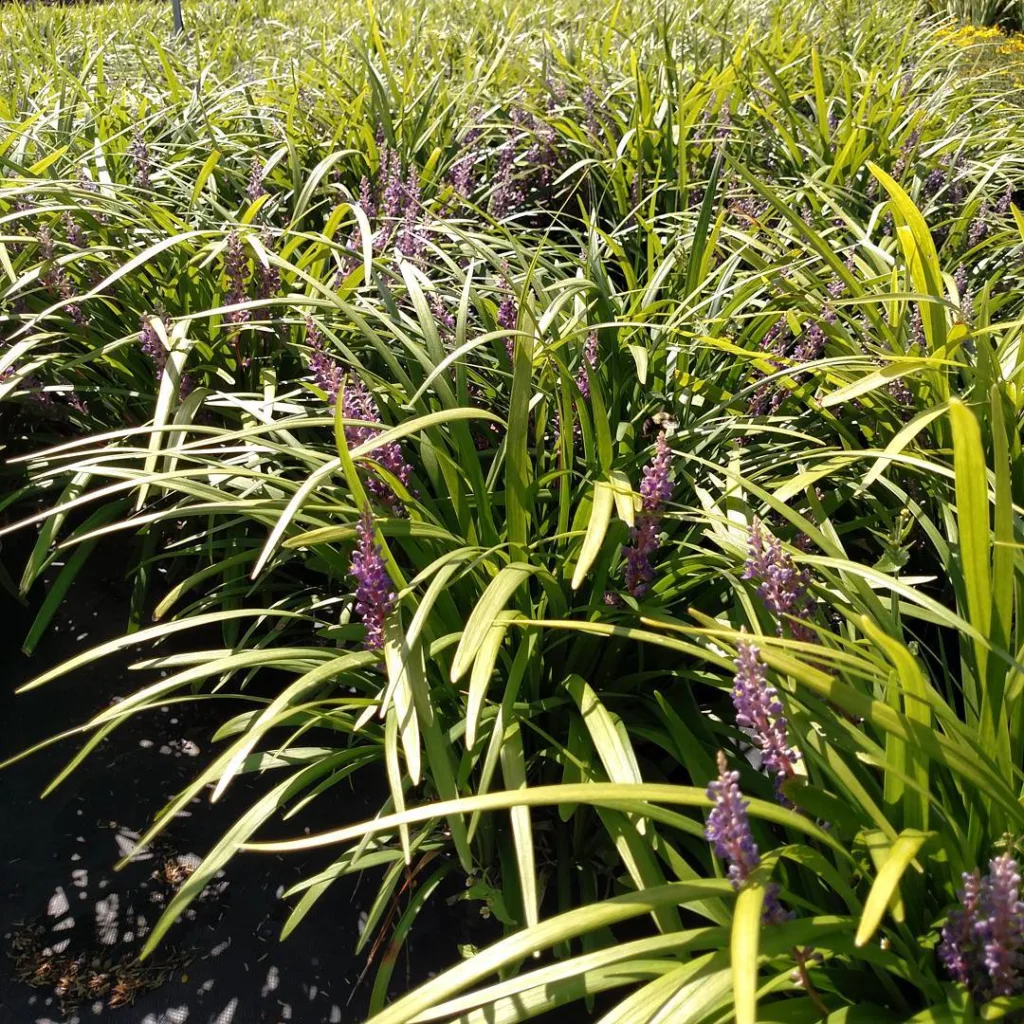
Introduction to Monstera obliqua: The “Mysterious” Plant with Holes
Monstera obliqua is an enigmatic plant species in the botanical world, renowned for its delicate, paper-thin leaves adorned with prominent, large fenestrations. This characteristic often leads to it being described as a plant with “more holes than leaf,” creating an elegant and captivating beauty for houseplant enthusiasts. Belonging to the Monstera genus (also known as the split-leaf philodendron family), this plant originates from the humid tropical rainforests of Central and South America, an environment whose native conditions profoundly influence its unique growth characteristics. Unlike its more common relative, Monstera deliciosa (the Swiss cheese plant), Monstera obliqua typically features thinner and smaller leaves, further accentuating its refinement. The exceptionally large holes in its leaves even earn it the evocative nickname “Swiss Cheese Plant on steroids,” emphasizing this one-of-a-kind leaf structure.
The allure of Monstera obliqua is intrinsically linked to its scarcity. True, pure specimens of this species are exceedingly rare in their natural habitat, making them highly sought-after by plant collectors. The plant collecting community often acknowledges this scarcity with the saying “it’s never obliqua” and the dedicated Instagram hashtag #itsneverobliqua, highlighting both its elusiveness and the prevalent mislabeling in the market. Botanical experts even remark that one is “more likely to be struck by lightning than to find this plant at a local nursery,” a testament to its genuine rarity. The plant’s inherently slow growth rate further contributes to its preciousness and high demand, as cultivating a mature specimen requires considerable time and patience. Adding to these challenges, propagating Monstera obliqua is notoriously difficult, severely limiting supply and consequently driving up market prices.
Understanding the market value of Monstera obliqua requires a nuanced perspective. While the average price of plants labeled “Monstera obliqua” in the U.S. online market has recently declined, with a median price of around $33 and a mean of $19.99 as of June 2025, this figure can be misleading. Younger plants or less developed propagations are often more affordable, with a median price of $30.60, approximately $1 cheaper than more mature, fully developed plants. However, verified, botanically pure cultivars like ‘Loreto’ or ‘Peru’ of Monstera obliqua command significantly higher prices, ranging from $199.88 to $345.88 for a single plant. This stark price disparity reveals a critical market reality. The lower average prices are frequently inflated by the common mislabeling of more prevalent species, notably Monstera adansonii, as Monstera obliqua. Meanwhile, the verified, pure cultivars retain their high value due to their genuine rarity and strong demand from specialized collectors. This difference underscores the urgent need for buyers to be exceptionally informed and cautious to avoid acquiring mislabeled specimens. This market trend also points to the widespread issue of plant misidentification within the horticultural trade and highlights the importance of consumer education and the necessity of purchasing from reputable, knowledgeable sources.
Distinguishing Monstera obliqua from Similar Species
The frequent mislabeling of Monstera obliqua with other Monstera species, particularly Monstera adansonii, Monstera esqueleto, and plants sold under the trade name ‘Monstera Peru,’ necessitates a clear understanding of their differences. These distinctions are not merely aesthetic but are fundamental to successful cultivation, as the care requirements vary significantly among these species.
Monstera obliqua and Monstera adansonii
Differentiating between Monstera obliqua and Monstera adansonii is paramount due to their frequent confusion and drastically different care needs. Monstera obliqua is exceedingly rare and often mislabeled in nurseries and plant shops, a reality so common it has spawned the saying “it’s never obliqua” and a dedicated hashtag to underscore its rarity. In contrast, Monstera adansonii is a staple plant and commonly found in garden centers.
Morphologically, Monstera obliqua is characterized by its paper-thin leaves with very large fenestrations, often giving the impression of “more holes than leaf.” Conversely, Monstera adansonii leaves are typically thicker, with a more robust leaf texture, and its fenestrations are often oval-shaped, which can mature into splits. A notable physical differentiator lies in stem thickness: Monstera obliqua possesses an exceptionally slender stem, often only about 2mm in diameter. Monstera adansonii (the typical form) has a thicker stem, while its ‘Narrow Form’ exhibits a thinner stem, resembling a vine.
In terms of growth habit and care, Monstera obliqua is a slow-growing plant that demands meticulous care, thriving only in enclosed, high-humidity environments (80% or above) and often not climbing when grown indoors. Monstera adansonii, on the other hand, is a fast-growing, vigorous climber and is considered much easier to care for. The reiterated emphasis on the extreme rarity of Monstera obliqua and its frequent misidentification as Monstera adansonii reveals a significant market and knowledge gap. This confusion is so widespread it has become a running joke in the plant collecting community. This isn’t merely an aesthetic difference; it represents a fundamental disparity in care difficulty and growth expectations. A buyer acquiring a true obliqua but expecting the ease of care of an adansonii is likely to face considerable challenges and risk the plant’s demise due to unmet environmental needs. This phenomenon underscores the critical importance of botanical accuracy in plant sales and the consumer’s need to research beyond common names to ensure they are prepared for the specific care requirements of the plant they are purchasing.
Monstera obliqua and Monstera esqueleto
These two species also differ in their fenestration patterns and care requirements. Monstera obliqua leaves feature “many fenestrations,” lending them an “ethereal, almost delicate beauty” due to the large proportion of holes. In contrast, Monstera esqueleto leaves have “larger holes and a more structured appearance,” appearing more robust. Its fenestration pattern is more complex than Monstera adansonii but with fewer holes than Monstera obliqua. In terms of care, Monstera esqueleto is generally considered easier to care for and more resilient than Monstera obliqua. Monstera obliqua, on the other hand, demands “more precision with humidity and light.” Monstera esqueleto is also known by the scientific name Monstera epipremnoides.
Monstera obliqua and ‘Monstera Peru’
The distinction between Monstera obliqua and plants sold under the name ‘Monstera Peru’ is particularly complex due to naming conventions. Monstera obliqua is a distinct plant species. ‘Monstera Peru,’ conversely, is primarily a common trade name, not an officially recognized botanical species, and is often used by growers and retailers to describe various plants, including Monstera karstenianum or certain variants of Monstera obliqua. Some sources even classify Monstera karstenianum ‘Peru’ under the Philodendron genus.
Regarding leaf shape and fenestration, the ‘Peru’ variant of Monstera obliqua is known for its “highly fenestrated leaves, meaning large holes can cover a significant portion of the leaf surface.” Monstera karstenianum ‘Peru’ is characterized by its corrugated, iridescent, and leathery leaves. While it also features “many holes and splits,” the leaves are generally relatively small with a distinct texture, whereas true obliqua forms develop larger fenestrations.
In terms of care difficulty, Monstera obliqua ‘Peru’ is recommended for “experienced plant enthusiasts” and requires high humidity and indirect light, much like other obliqua forms. Monstera karstenianum ‘Peru,’ conversely, is generally described as easy to care for and a good choice for beginners. The term “Peru” causes significant confusion as it’s applied to two distinct plants: Monstera karstenianum ‘Peru’ and Monstera obliqua ‘Peru.’ The former is a relatively easy-care plant with corrugated leaves, while the latter is a rare variant requiring the meticulous care of a Monstera obliqua with abundant fenestrations. The general trade name “Monstera Peru” can refer to either, or even other plants, depending on the seller. This highlights the urgent need for buyers to understand precise botanical names and specific characteristics, rather than relying solely on common names or regional trade monikers. This prevalent naming confusion can lead to significant disappointment for plant enthusiasts or even plant death if a buyer acquires a Monstera obliqua ‘Peru’ with high care demands but expects the simple care of a Monstera karstenianum ‘Peru.’ This emphasizes the necessity of verifying the exact botanical name and distinguishing features before purchase.
To provide a clear reference, the following table summarizes the comparative characteristics of Monstera obliqua and its commonly confused counterparts:
| Plant Name | Rarity | Leaf Shape | Stem Thickness | Care Difficulty | Humidity Needs | Growth Rate | Climbing Ability |
| Monstera obliqua | Extremely Rare | “More holes than leaf” / delicate / paper-thin | ~2mm | High (precise) | 80%+ (enclosed) | Very Slow | Often not climbing indoors |
| Monstera adansonii | Common | Thicker / oval fenestrations / splits | Thick (typical form) / thinner (narrow form) | Easy | 50-90% (tolerates average) | Fast | Climbs readily |
| Monstera esqueleto | Rare | Large holes / structured / skeletal | Undetermined (but more robust than Obliqua) | Medium | High (tolerates average) | Undetermined (but faster than Obliqua) | Climbs |
| Monstera karstenianum ‘Peru’ | Uncommon | Corrugated / leathery / few fenestrations | Undetermined | Easy | Undetermined (but generally average) | Fast | Undetermined |
Xuất sang Trang tính
Export to Spreadsheet
Comprehensive Care Guide for a Thriving Monstera Obliqua
Successfully cultivating Monstera obliqua demands a precise and consistent approach to its environmental needs, owing to its delicate nature and scarcity. This plant is not recommended for novice houseplant enthusiasts due to its specialized requirements.
Light Requirements
Monstera obliqua thrives in medium to bright indirect light conditions. For optimal growth and health, it requires a minimum of seven hours of bright, indirect light daily. Direct sunlight must be entirely avoided, as it can easily scorch the plant’s paper-thin leaves, which are highly susceptible. Conversely, insufficient light conditions are also detrimental, leading to fewer fenestrations and stunted growth, diminishing the plant’s iconic appearance. Many experienced growers find supplementing natural light with grow lights to be essential, especially when cultivating these plants in controlled environments like grow cabinets or terrariums, to ensure consistent and optimal light exposure. The extreme fenestrations on Monstera obliqua leaves signify a reduced amount of chlorophyll, directly leading to a heightened sensitivity to harsh light conditions. Too much direct light causes leaf scorch due to the delicate leaf tissue, while insufficient light hinders the development of characteristic fenestrations, the plant’s hallmark. This creates a very narrow and precise “sweet spot” for light intensity. The plant’s unique anatomical structure directly dictates its crucial light needs. Achieving the precise lighting conditions isn’t just about promoting general growth; it’s about maintaining the aesthetic (fenestrations) that makes Monstera obliqua so desirable and rare. This implies that careful placement, possibly with the aid of grow lights or diffused natural light, is often indispensable for optimal plant health and the full expression of its unique foliage.
Watering Best Practices
The soil for Monstera obliqua should be kept consistently moist but never waterlogged. This balance is crucial, as overwatering is a primary culprit for root rot, a common and potentially fatal issue for this species. It’s advisable to allow the top inch or two (2.5 – 5 cm) of soil to dry out before watering again. When watering, thoroughly saturate the soil until excess water drains completely from the pot’s drainage holes. It is vital to discard any standing water in the saucer to prevent the plant from becoming waterlogged, which can lead to oxygen-deprived roots and rot. Given its slow growth rate, watering may only be necessary once every week or two during the active growing season. During the fall and winter months, the watering frequency should be significantly reduced. Rather than adhering to a rigid watering schedule, regularly checking the soil’s moisture with a finger or a moisture meter is recommended to accurately determine when watering is needed. Monstera obliqua requires “consistently moist” soil yet is highly susceptible to root rot if overwatered. This seemingly contradictory requirement is a common challenge in caring for tropical plants. The solution lies in a combination of “well-draining soil” and allowing “an inch or two at the top to dry.” This suggests the need for moisture within the root ball (where the plant draws water) while ensuring rapid drainage of any excess water from the pot. The term “consistently moist” refers to the ideal state of the root ball itself, not necessarily the surface soil. This nuanced understanding of watering emphasizes that proper soil aeration and drainage, as detailed in the soil section, are the ultimate safeguards against root rot, even with frequent watering. It also reinforces the necessity of careful, adaptive monitoring (finger test or moisture meter) rather than a fixed watering schedule.
Humidity: A Critical Factor
Monstera obliqua demands extremely high humidity levels, ideally 80% or above, to mimic its native tropical rainforest environment. Insufficient humidity will cause the plant’s signature paper-thin leaves to wilt and die, underscoring the critical nature of this environmental factor. An enclosed environment, such as a grow cabinet, terrarium, or grow tent, is often the most effective place to control and maintain the necessary high humidity levels, frequently with the assistance of a humidifier. While methods like pebble trays, clustering plants, and regular misting can increase ambient humidity, misting alone is typically insufficient for Monstera obliqua’s high humidity needs. Small temperature and humidity readers should be utilized for accurate monitoring and adjustment of environmental conditions, ensuring the plant’s specific requirements are met. The consistent and strong emphasis across multiple sources on “80% or higher” humidity and the severe consequences of wilting and leaf death due to inadequate humidity makes it clear that average household humidity levels (often 40-60%) are insufficient for this species. Therefore, conventional methods like humidifiers, pebble trays, and misting, while beneficial for many houseplants, may fall short for the long-term flourishing of Monstera obliqua. This elevates the role of enclosed environments (grow cabinets, terrariums, tents) from a “desirable” to a “necessary” condition for sustained health and growth. The plant’s exceptionally delicate leaf structure is a direct adaptation to its native high-humidity tropical environment, and replicating this is paramount for its survival in cultivation. This specific and stringent humidity requirement positions Monstera obliqua as a plant primarily suited for dedicated collectors willing to invest in and maintain specialized environmental control setups, rather than a typical houseplant for average indoor conditions. It also explains why its reputation for being “finicky” largely stems from this critical humidity factor.
Ideal Soil Mix
Monstera obliqua requires a nutrient-rich, well-draining, and airy potting mix that still retains moisture effectively. Popular recommendations for a suitable mix include a blend of houseplant potting soil and perlite, or a specific ratio of 1/3 orchid bark, 1/3 perlite, and 1/3 compost. Adding sphagnum moss as a top layer can enhance surface moisture and humidity. Other beneficial additions for aeration and drainage include coco coir, charcoal, and worm castings, which contribute to the overall health of the root system. While plants with thicker roots, like Monstera karstenianum ‘Peru’ (often mistaken for obliqua), can thrive in LECA, this medium requires careful and consistent nutrient management as it lacks inherent nutrients. The plant generally prefers slightly acidic to neutral pH soil. The ideal soil mix for Monstera obliqua demonstrates a delicate balance: it must be “well-draining and airy” to prevent root rot while still being capable of “retaining some moisture effectively.” This seemingly contradictory requirement is achieved by combining organic materials (like peat moss, coco coir, compost, and bark) that retain moisture and provide structure, with inorganic materials (like perlite, pumice, LECA, and grit) that promote aeration and faster drainage. The emphasis on “chunky components” in the soil mix further supports the critical need for excellent airflow around the roots, preventing stagnation. A standard potting mix is insufficient and likely detrimental to Monstera obliqua. A customized or specialized aroid mix is essential to circumvent the most common issue for this species: root rot due to overly dense or waterlogged soil, which directly impacts its survival and development.
Temperature Needs
The ideal temperature range for Monstera obliqua is between 20°C to 30°C (68°F to 86°F). Some sources specify an optimal temperature around 25°C (77°F). It is crucial to avoid exposing the plant to temperatures below 10°C (50°F), as cold can cause significant damage and hinder growth. Cold drafts and sudden temperature fluctuations must also be strictly avoided, as they can stress the plant, potentially leading to visible issues like yellowing leaves or stunted growth. While Monstera obliqua can tolerate a specific temperature range, the repeated emphasis on avoiding “cold drafts and sudden temperature changes” suggests that temperature stability is as important as the absolute range. Sudden drops or cold drafts can induce significant stress on the plant, potentially leading to visible issues like yellowing leaves or stunted growth. This is particularly relevant in indoor environments where heating and cooling systems can cause fluctuations, or where plants are placed near drafty windows or doors. Maintaining a consistently warm environment (often more easily achieved within a sealed grow cabinet or terrarium) is vital for the plant’s overall health and enhances its resilience to other environmental stressors.
Fertilizing Schedule
As a slow-growing plant, Monstera obliqua requires less frequent fertilization compared to faster-growing Monstera species. A water-soluble liquid fertilizer, diluted to half the recommended strength, should be applied monthly during the active growing season of spring and summer. It is essential to cease fertilization in the fall as temperatures begin to drop, and avoid any fertilizing during the fall and winter months when the plant is dormant, as its metabolic activity slows considerably. Over-fertilization must be avoided, as it can lead to salt buildup in the soil and chemical burns on the roots, causing irreparable damage. The classification of Monstera obliqua as a “slow-growing” plant directly indicates its lower nutritional requirements compared to more vigorous Monstera relatives. Over-fertilizing a slow-growing plant is a common mistake that can lead to nutrient burn and irreversible root damage. The recommendation to use a “diluted” fertilizer and apply it monthly during the active growing season is a direct adaptation to this slower metabolic rate and delicate root system. This highlights that effective plant care is not a “one-size-fits-all” approach. Understanding the plant’s inherent growth rate and specific needs is crucial for tailoring its nutrient intake, thereby preventing common issues arising from over or inappropriate feeding.
Support for Growth
It is highly beneficial to provide Monstera obliqua with a moss pole, trellis, or other suitable climbing structure. As a vining plant, providing this support encourages the development of larger, healthier leaves, enhancing its aesthetic appeal. This practice mimics its natural climbing habit in the wild, where Monstera species use their aerial roots to attach to trees and other supports, allowing them to mature and access more light. The necessity of providing structural support (moss poles, trellises) for Monstera obliqua extends beyond mere vertical growth; it is fundamentally tied to the plant’s natural semi-epiphytic growth habit. In their native environments, climbing allows mature Monstera plants to reach greater heights, access more light, and consequently develop their characteristic fenestrations. Replicating this support indoors encourages this natural behavior, leading to the development of larger, more fenestrated leaves, which are the defining characteristic of Monstera obliqua. Providing adequate support is a critical component of advanced Monstera care, moving beyond basic survival to actively encouraging the plant’s full genetic potential and the iconic appearance that makes it so sought-after.
Pruning for Health and Shaping
Pruning Monstera obliqua is generally not strictly necessary for its survival but can be highly beneficial for maintaining its desired size and shape. Any yellowing or damaged leaves should be promptly removed as they appear, which redirects the plant’s energy towards new, healthy growth. If pruning is needed to control size or address legginess, it should be done during the active growing season (spring/early summer) to minimize stress and promote faster recovery. Always use clean, sharp scissors or pruners to make precise cuts, which minimize damage to the plant and prevent pathogen entry. It is crucial to avoid removing more than one-third of the plant’s total mass at any given time, as over-pruning can cause significant stress, especially to a delicate species like obliqua. Pruning serves a dual purpose for Monstera obliqua: it contributes to the plant’s overall health by removing old or damaged foliage, and it allows for shaping the plant to suit aesthetic preferences or space constraints. The critical advice to remove no more than one-third of the plant at once is a direct risk-mitigation strategy to prevent “shock” to an already sensitive plant. Pruning is an active management technique that significantly contributes to both the plant’s vitality and its appearance in an indoor setting, allowing collectors to maintain its beauty and form.
Repotting Guidance
As a slow-growing Monstera, Monstera obliqua typically only requires repotting every few years. Key indicators that it is time to repot include roots emerging from the drainage holes or tightly circling within the pot, signaling that the plant is root-bound and its growth is restricted. The optimal time for repotting is in the spring or early summer, when the plant is actively growing and can recover more readily from the disturbance. When repotting, it is advisable to choose a new pot that is only one to two inches (2.5 – 5 cm) larger than its current container. Monstera plants generally tolerate being slightly root-bound better than being over-potted, as an oversized pot can retain too much moisture, leading to root rot. It is beneficial to refresh as much of the old soil as possible without disturbing the root ball, and to water the plant thoroughly after repotting to help it settle into its new environment. The recommendation for infrequent repotting (every few years) and choosing only a slightly larger pot (1-2 inches bigger) is a direct consequence of Monstera obliqua’s slow growth rate and its susceptibility to root rot in overly large, moisture-retentive pots. Overpotting can lead to excess soil that remains wet for extended periods, creating anaerobic conditions detrimental to root health. This careful approach minimizes stress and ensures the plant’s delicate root system has adequate space without being excessively waterlogged. This highlights that repotting is not a routine task but a strategic intervention tailored to the plant’s growth and specific environmental needs, crucial for preventing common issues.
Propagation Methods
Propagating Monstera obliqua is known to be very difficult, contributing significantly to its rarity and high cost. The process typically involves stem cuttings, similar to other Monstera and aroid species. Cuttings can be taken from a mother plant or a creeping vine. To achieve the best success rate, propagation should be performed in the spring when the plant is actively growing and has the most energy for root development. For stem cuttings, the following step-by-step method is recommended:
- Take a cutting from a healthy, mature plant using clean, sharp pruning shears. The ideal cutting should have at least two nodes and one leaf to ensure sufficient energy for new growth.
- Remove any leaves from the lower portion to expose the nodes on the stem, as these are where new roots will emerge.
- Plant the cutting in a pot filled with moist sphagnum moss, ensuring the lower nodes are fully covered. Sphagnum moss is often preferred for propagation due to its excellent aeration and moisture-retention properties.
- Place the cutting in a warm, high-humidity environment, such as a greenhouse, grow cabinet, or terrarium. High humidity is critical for successful propagation and to prevent the delicate cutting from dehydrating.
- Keep the sphagnum moss consistently moist but not soggy to avoid fungal issues.
- If successful, aerial roots will begin to emerge within a few weeks.
- Once the aerial roots are at least an inch (2.5 cm) long, the cutting can be transferred to a well-draining soil mix similar to that used for mature obliqua plants.
Other methods, such as air layering, involve encouraging roots to grow on a node while it is still attached to the mother plant, by wrapping it in moist sphagnum moss and plastic wrap. Once roots have formed, the sectioned branch is cut and potted. This method has a higher survival rate as the cutting is only separated after roots have developed. Water propagation, where cuttings are placed in water with nodes submerged and water changed regularly, can also be done but may have a slightly lower success rate than air layering. The explicit mention of propagation being “difficult” and contributing to the plant’s “rarity and high cost” is a direct cause-and-effect link. Unlike many common houseplants that readily propagate, Monstera obliqua’s slow rooting and sensitivity during this phase have limited mass production. This inherent difficulty in reproduction directly restricts supply, drives up market prices, and solidifies its status as a collector’s item. This highlights that the plant’s high value is not solely due to perceived rarity but also to the significant horticultural skill and time investment required for successful propagation.
Troubleshooting Common Issues and Maintaining Plant Health
Even with meticulous care, Monstera obliqua owners may encounter common problems. Understanding the signs, causes, and solutions is crucial for maintaining the plant’s health and preserving its unique beauty.
Recognizing and Addressing Yellow Leaves
Yellowing leaves are a common symptom in Monstera obliqua, often indicating an environmental imbalance. This discoloration can stem from improper watering practices, including both overwatering and underwatering. Specifically, overwatering can lead to root rot, which impairs the plant’s ability to absorb essential nutrients. Conversely, a lack of water can cause leaves to yellow as the plant attempts to conserve moisture. Insufficient light is another frequent culprit, as too little light can result in pale or yellow leaves due to inadequate photosynthesis. Nutrient deficiencies, particularly a lack of nitrogen, can also manifest as generalized yellowing foliage. Furthermore, temperature stress from cold drafts or sudden changes can cause foliage to yellow. It should also be noted that older leaves, typically at the bottom, may naturally yellow and drop as the plant redirects energy towards new, healthy growth.
Addressing yellow leaves often requires a multi-faceted approach. Watering practices should be adjusted to allow the top one to two inches (2.5 – 5 cm) of soil to dry between waterings, ensuring good drainage and preventing waterlogged conditions. If root rot is suspected, the plant should be removed from its pot, affected roots trimmed, and repotted into fresh, well-draining soil. Light conditions should be optimized by moving the plant to a location that provides bright, indirect light, with supplemental grow lights if necessary. Appropriate fertilization using a balanced liquid fertilizer at half strength during the growing season can correct nutrient deficiencies. Maintaining a consistently warm environment, free from drafts, will mitigate temperature-related stress. Finally, yellowed leaves can be pruned for aesthetic improvement and to redirect the plant’s energy. The frequent yellowing of Monstera obliqua leaves and the myriad of potential causes underscore a critical point: the plant’s health is a delicate balance of interconnected environmental factors. A single symptom like yellow leaves can stem from issues with light, water, nutrients, or temperature, and these factors often influence each other. For example, overwatering in low-light conditions exacerbates root rot. This complexity necessitates a comprehensive diagnostic approach where the owner systematically assesses all care parameters rather than focusing solely on one issue. This holistic evaluation is essential for accurate diagnosis and effective remediation.
Treating Brown Leaf and Leaf Tip Edges
Brown leaf or leaf tip edges are typically a sign of environmental stress. Low humidity is a primary cause, especially for the delicate foliage of Monstera obliqua. Insufficient humidity or dry soil can also lead to crispy, brown leaf edges. Direct sunlight or sunburn is another significant factor, as harsh light can scorch leaves, causing them to turn brown. Over-fertilizing can lead to chemical burn, resulting in brown leaf tips. In cases of overwatering, root rot can manifest as brown spots or mushy stems.
To remedy brown leaf edges, increasing humidity is paramount, ideally maintaining 80%+ with a humidifier. Grouping plants together or using pebble trays can also contribute to higher ambient humidity. Watering practices should ensure consistent moisture without waterlogging, allowing the topsoil to dry between waterings. The plant should be moved out of direct sunlight to a location that provides bright, indirect light.
If i die, water my plants!



